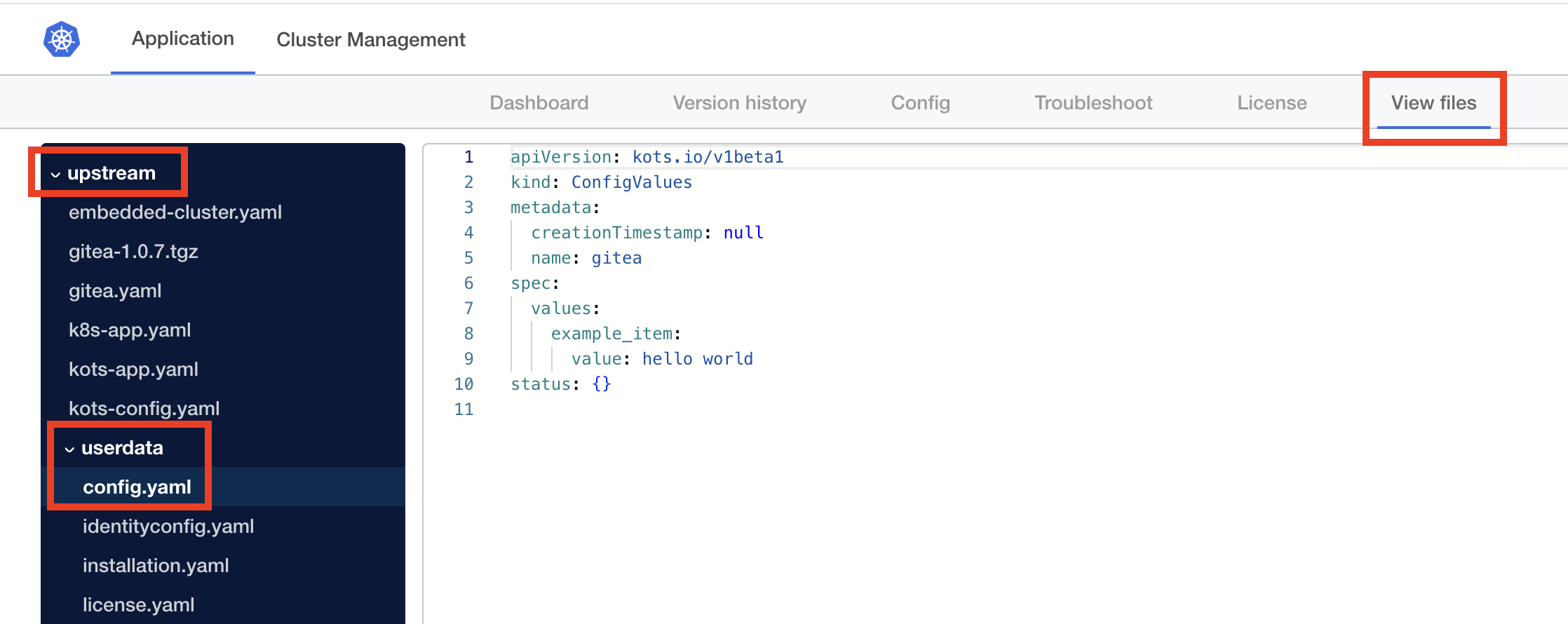Generating a ConfigValues File
This topic describes how to generate the Replicated KOTS ConfigValues file for an application release. It also includes recommendations for how to prepare a sample ConfigValues file to be shared with your users.
Overview
The KOTS ConfigValues file includes the fields that are defined in the KOTS Config custom resource for an application release, along with the user-supplied and default values for each field. The following is an example of a ConfigValues file:
apiVersion: kots.io/v1beta1
kind: ConfigValues
spec:
values:
text_config_field_name:
default: Example default value
value: Example user-provided value
boolean_config_field_name:
value: "1"
password_config_field_name:
valuePlaintext: examplePassword
The ConfigValues file allows you to pass the configuration values for an application from the command line with the install command, rather than through the Admin Console UI. This supports automated or headless installations, such as when installing an application as part of CI/CD pipelines.
For more information about installing from the command line, see Installing from the Command Line.
Get the ConfigValues File
During installation, KOTS automatically generates a ConfigValues file and saves the file in a directory called upstream. After installation, you can view the generated ConfigValues file in the Admin Console View files tab or from the command line by running the kubectl kots get config command.
To get the ConfigValues file from an installed application instance:
-
Install the target release in a development environment. You can either install the release with Replicated Embedded Cluster or install in an existing cluster with KOTS. For more information, see Online Installation with Embedded Cluster or Online Installation in Existing Clusters.
-
Depending on the installer that you used, do one of the following to get the ConfigValues for the installed instance:
-
For Embedded Cluster installations: In the Admin Console, go to the View files tab. In the filetree, go to upstream > userdata and open config.yaml, as shown in the image below:

-
For KOTS installations in an existing cluster: Run the
kubectl kots get configcommand to view the generated ConfigValues file:kubectl kots get config --namespace APP_NAMESPACE --decryptWhere:
APP_NAMESPACEis the cluster namespace where KOTS is running.- The
--decryptflag decrypts all configuration fields withtype: password. In the downloaded ConfigValues file, the decrypted value is stored in avaluePlaintextfield.
The output of the
kots get configcommand shows the contents of the ConfigValues file. For more information about thekots get configcommand, including additional flags, see kots get config.Example:
kubectl kots get config --namespace namespace --decryptapiVersion: kots.io/v1beta1
kind: ConfigValues
metadata:
creationTimestamp: null
spec:
values:
example_item:
value: hello world
-
Share a Sample ConfigValues File
If your users will perform automated or headless installations from the command line, you can share an example of an accurate ConfigValues file that they can edit.
Before sharing a sample ConfigValues with users, Replicated recommends that you edit the sample file in the following ways:
-
Remove any configuration fields that have
readonlyset totrue. Users cannot edit read only fields. For more information, see readonly in Config. -
Remove the
metadataandstatusfields. These fields are automatically generated because the file is a Kubernetes custom resource. KOTS does not use themetadataorstatusfields. -
(Optional) Remove any fields that have
hiddenset totrue. Fields withhiddenset totruecan be edited by users, but are hidden from the Admin Console Config page. For more information, see hidden in Config. -
Write comments in the file or provide supplementary documentation to describe the following:
-
The fields that are required and optional. For any required configuration fields that do not have a default value, users must provide a value in the ConfigValues file to install the application.
-
The supported values for each configuration field. For example, for
radioordropdownfields, document each of the possible values that users can provide. -
The supported YAML format for each value. The following table describes the supported value format for each configuration field type:
Field Type Supported Value Format bool"1"specifies true and"0"specifies false.bool_config_field:
value: "1"bool_config_field:
value: "0"fileA
filenamefield and a Base64 encoded string of the contents of the file in thevaluefield.file_config_field:
filename: my-file.txt
value: JVBERi0xLjQKMSAw...passwordA
valuePlaintextfield that contains the password in plain text. KOTS encrypts any values invaluePlaintextfields during installation.password_config_field:
valuePlaintext: myPlainTextPasswordradioanddropdownThe
valuemust match the name of one of the nested items for theselect_onefield as defined in the Config custom resource manifest.radio_config_field:
value: option_nametextPlain text in the
valuefield.text_config_field:
value: This is a text field value.textareaPlain text in the
valuefield.textarea_config_field:
value: This is a text area field value.For more information about each configuration field type in the Config custom resource, see Config.
-